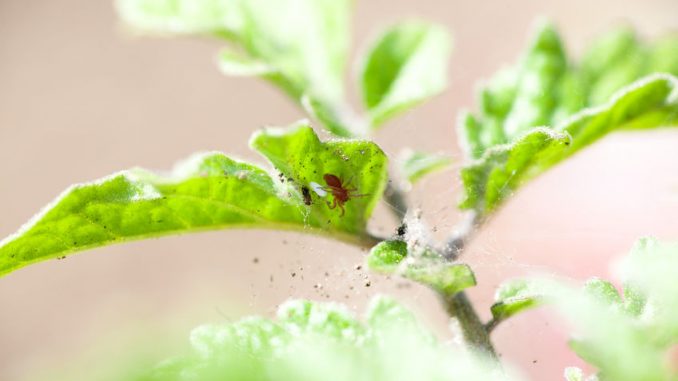
The Glasshouse red Spider Mite (Tetranychus urticae) is a common sap-feeding pest that affects many plants grown in the greenhouse and indeed the garden generally. Great damage is done when temperatures are high which produce massive population explosions.
Symptoms
A fine, pale, mottled discolouration develops on the upper leaf surfaces. In heavy attacks, leaves can dry up and fall prematurely. When mite numbers are high, a fine silk webbing is produced, strung between leaves. The adult mites, best seen with a hand lens, are less than one mm long and yellowish green with darker markings or are sometimes black in colour. In autumn and winter, the overwintering mites are orange to red.
Biology
Eggs, nymphs and adults live mainly on the underside of leaves. Hot, dry conditions favour the mite when it can complete its life cycle in as little as 7 days. In gardens and unheated glasshouses, it overwinters as non-feeding adults but in warm situations it may be active throughout the year. In gardens, damage generally does not start before mid-summer; in glasshouses and on house plants mites can be a problem from March onwards.
Control
Insecticides such as by bifenthrin (Scotts Bug Clear, Bio Sprayday Greenfly Killer Plus or Doff All-In-One Garden Pest Killer) can be used but spider mite is sometimes resistant to this pesticide. Resistance is less likely to occur with organic sprays such as vegetable oils, (Bio-Organic Pest Control) or fatty acids (ready-to-use sprays like Bio Organic Pest Control, Doff House Plant Pest Spray) but these will need more frequent application. An effective alternative treatment is biological control with the predatory mite Phytoseiulus persimilis. This can be used from April to October and is available from mail-order suppliers. The predator needs to be introduced before the heavy infestation has developed and requires daytime temperatures of 21 centigrade (70 Fahrenheit) or more. Some insecticides such as bifenthrin can remain harmful to the predator for up to 10 weeks and should be avoided where biological controls are being used. Phytoseiulus is more reliable in glasshouses, but can be used on outdoor plants in mid to late summer. Damping down glass houses and spraying water on to the underside of leaves creates less favourable conditions for red spider and reduces its breeding rate.
Look out for the red spider mite on plants like tomatoes, peppers (sweet and chilli), cucumbers, melons, courgettes and aubergines.
Leave a Reply